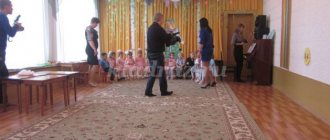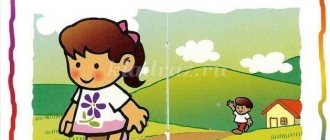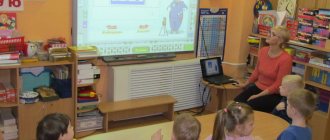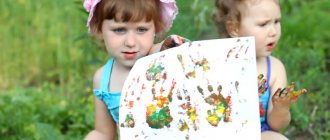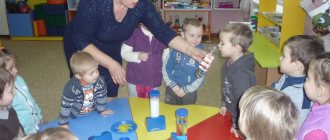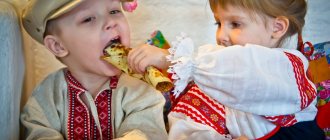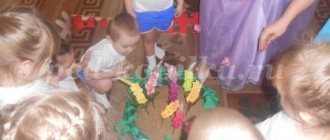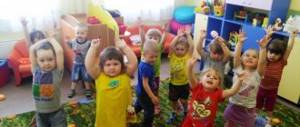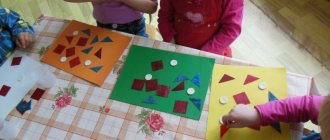Features of conducting applicative classes in the senior group
A doll at its core is a reflection of the human image. This toy can represent people of any age and gender and express a certain character. In addition, the doll can symbolize a certain time of year or be a fantasy anthropomorphic creature like Maslenitsa or a Slavic amulet.
During the applicative lesson, preschoolers are invited to convey one of the indicated images using scissors, glue, paper and other auxiliary materials.
By portraying a familiar doll, children clarify their knowledge about the structure of a person and the relative size of the parts of his body.
Let us note that the depiction of fictional objects is usually easy for children, because by nature they are inventors and dreamers. When portraying such a doll, the child does not need to pay much attention to proportions.
Often the applique image of a doll is made up of simple geometric shapes. A more difficult job is cutting out individual symmetrical parts (dress or sundress) from paper folded in half. The application on the “Doll” theme also trains preschoolers in cutting shapes in a straight line, along a fold.
In the older group, the guys are already good at cutting out circles and ovals (doll's head) from squares and rectangles.
During a lesson on this topic, it is appropriate to use an individual approach: for example, children who can quickly cope with the main work can decorate a doll’s clothes with an ornament of geometric shapes or abstract elements.
An important part of any artistic pursuit is the analysis of finished works. The guys evaluate their compositions and the crafts of their comrades. The teacher, with the help of leading questions, finds out what was the most interesting in the work, and what, on the contrary, caused difficulties. You can invite preschoolers to come up with a name for their doll and talk about its character.
The process of preparing for the lesson, options for manufacturing parts
Pupils of the senior group can make not very complex parts for applique dolls on their own: for example, cut out round and oval shapes from squares and rectangles, cut a sheet of paper into strips along straight lines or folds. It is clear that preschoolers independently tear paper into pieces for crafts using the tearing technique. In this case, the parts should be approximately the same size: not too large, but not small either. Children can cut the strips into squares for mosaic appliqué.
Children five to six years old also independently cut out symmetrical clothes for a doll - dresses and sundresses of a simple style.
However, if the application involves the use of more intricate silhouettes that need to be correctly superimposed on each other, then the teacher provides them to the children.
Let us remind you that in any case, the teacher provides children with more details than is required to complete the task. In this case, the guys will not be afraid of accidentally ruining some element.
Types of appliqué on a doll in a beautiful dress in the older group, appropriate for making a composition
In addition to the classical technique, based on various techniques for cutting out parts, students in the senior group can make a doll using various non-traditional techniques.
For example, children are always interested in cut-out appliqué, which, moreover, develops fine motor skills very well. The teacher gives the preschoolers silhouettes of the doll, and they fill them with details of different colors, in this way denoting body parts and items of clothing.
Broken applique
The same principle applies to work using the mosaic technique, only here children are provided with ready-made parts - small circles, squares, triangles.
The pouring technique is very original, when cereals or leaves, ground into crumbs, are sprinkled onto a doll’s silhouette smeared with glue.
Application from leaves, including those ground into crumbs
In general, leaf applique is the most appropriate way to depict an Autumn doll.
Collective application of leaves
Application of leaves and berries
You can include weaving elements in the applicative composition by making, for example, a doll’s braid in this way. You can weave from paper strips, braid, thick yarn.
Volumetric applique always looks impressive. This effect is achieved by including origami elements in the craft, folding parts into an accordion, and multi-layer appliqué (the flounces of a doll’s full skirt or her hairstyle are usually formed in this way). Volume is also achieved by placing cotton wool under the paper part - the composition is more expressive.
Note that often applicative techniques are not used in their pure form, but are combined in crafts.
The most suitable material for the job, including base design, as well as additional accessories
Such a fascinating theme for appliqué as a doll requires the use of a variety of materials. In addition to traditional colored paper and cardboard, you can create crafts from fabric, yarn and even faux fur.
Applique made of fabric, yarn and fur
Colorful clothes for a doll are made well from bright glossy magazine paper. In addition, shiny candy wrappers are very useful.
Application using candy wrappers
Application using candy wrappers
The original solution is a dress made from pencil shavings. This outfit looks simply luxurious.
Pencil shavings applique
To create a delicate flowing sundress, you can use colored napkins and corrugated paper. An interesting solution is to cut out a face from a photograph, this way you can depict a whole family - grandmother, daughter and little granddaughter.
Application using photographs
In addition, the face can be formed using cotton wool or a cotton pad, gluing button eyes on top.
Applique made of fabric, cotton wool and yarn
To applique the doll, you can also use waste material, for example, wooden ice cream sticks, with which you can depict legs.
Application using waste material - ice cream sticks
As for the Maslenitsa doll, a variety of materials are used to create it. So, a large head can be made from a cardboard plate. Rays can radiate from it, like the sun’s, from cotton swabs, toothpicks, cut cocktail tubes, thick yarn, satin ribbons.
Elements of drawing or modeling always look appropriate in an applicative composition. Thus, the doll’s face is often drawn with felt-tip pens, and her paper outfit can be decorated with plasticine parts.
Application with drawing elements
Summary of a lesson on application for children in the senior group of kindergarten
Summary of a lesson on appliqué for children 5-6 years old
Goal: to develop accuracy and a desire to help. The material will be useful for educators to use for classes with a group of children aged 5-7 years, as well as for parents and students. 1. Topic: “Outfits” 2. Senior group 3. Preliminary work : Conversation “clothing”, “studio” 4. Material: Handout: sequins, braid, glue, scissors, dress templates, colored paper, napkins, scissors, simple pencil , for each child half a sheet of A4. Demo: Dress, finished work, package, letter. 5. Program content: Continue to learn the rules when using scissors;
Develop hand motor skills; cultivate neatness. Contents of educational activities:
Introductory part. Surprise moment Educator: Guys, today we are with you, oh, do you hear someone knocking so loudly! (the teacher opens the door to no one, there is a package lying there) Guys, a package has arrived for us. Let's see what's there. Children: come on. Oh look what is this? I think it’s some kind of decoration, and there’s also a letter here, let’s read it. (The teacher reads the letter: Hello guys, we need help, the sewing machines in our atelier are broken, and we can’t make dresses for our models, please help, I sent you the decorations for the dresses in a parcel, thank you in advance. Aunt Nellie.) Well What guys can we help? Children: Yes! Educator : Then let's get to work, now I will give you all the materials for making dresses. (The teacher gives the children the materials that were in the package. Main part: Educator: Guys, look at the dress template, it's not whole, only half, how can we draw the second part of the dress? Children: we don’t know. Educator: Look, you need to fold your sheet of colored paper vertically in half, put it like this, trace the template, cut it out and unfold it and get a whole dress. (showing and doing it step by step) Educator: Now we can glue it onto the paper our dresses. (The children are gluing.) And now let's rest. Physics minute. Pinocchio stretched, Bent over once, Bent over twice, Spread his arms to the sides. Apparently he didn't find the key. To get the key for us, We need to stand on our toes. Educator: Well done, they did everything quickly and clearly movements, and now let's finish our dresses. Guys, look how many decorations we have, you can choose the ones you like, and I'll show you how we will decorate. Look, I'll smear glue on my dress and use sequins, that's what these decorations are called to stick on dresses, It’s working out great, and now you can decorate your dresses. (Individual assistance while decorating dresses.) The final part. Educator: Guys, just look at what beautiful dresses we made, and what is the name of the decoration we used to decorate? (children answer) Let’s make our own exhibition of dresses, they are so beautiful, let’s admire them, and then send them to the atelier, now put yours here dress up, and clean up your work areas.
We recommend watching:
Summary of GCD for introducing older preschoolers to the work of the poet Fet Summary of plot-based GCD in physical education for children of the senior group Summary of GCD in the senior group of compensatory orientation GCD in kindergarten for older preschoolers
Similar articles:
Summary of GCD in the senior group on the topic “Communication”
Summary of GCD in the senior group of kindergarten on the topic “Relaxation”
Summary of a lesson on cognition in the senior group on the topic “Dairy products”
Summary of a lesson on cognition in the senior group on the topic “Construction professions”
Abstract of educational activities for cognition in the senior group of kindergarten on the topic “Russian folk crafts”
